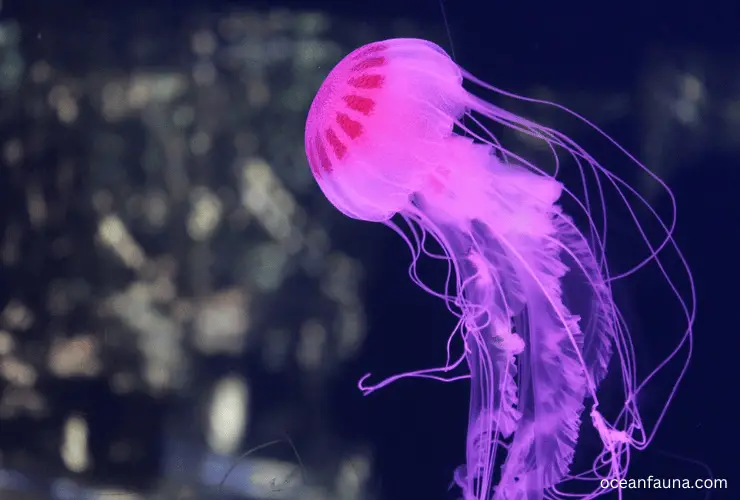Yes, jellyfish do have genders. Some species of jellyfish are hermaphrodites, meaning they have both male and female reproductive organs, while others are either male or female. Hermaphroditic jellyfish are capable of self-fertilization as well as fertilizing others of their own species.
In sexual reproduction, male jellyfish release sperm into the water, which fertilizes the eggs of the female jellyfish.
The fertilized eggs then develop into larvae, which eventually settle and grow into adult jellyfish.
It’s important to note that the study of jellyfish reproduction and gender is still ongoing, and more research is needed to understand the complexities of jellyfish sexuality fully.
Do Jellyfish Have Genders?
Yes, jellyfish do have genders and can be classified as male or female depending on their reproductive organs.
However, there is a special kind of jellyfish, also known as hermaphroditic jellyfish, which have both male and female reproductive organs. These jellyfish can self-fertilize, which means they don’t require a mate for reproduction.
They can also fertilize others of their own kind, aiding reproduction in jellyfish.
How To Tell the Gender of a Jellyfish? The Difference Between Male and Female Jellyfish
Determining the gender of a jellyfish can be challenging as they do not have distinguishable physical characteristics like mammals.

The distinction between male and female jellyfish often depends on their reproductive organs, which are not always visible.
In species of jellyfish that are not hermaphroditic, male and female individuals have separate reproductive organs. Male jellyfish have gonads, which produce and release sperm into the water, while female jellyfish have gonads that produce eggs.
In hermaphroditic species of jellyfish, individuals have both male and female reproductive organs. These jellyfish can either self-fertilize or fertilize others of their own species.
Note: It is important to note that the identification of the gender of jellyfish can only be determined through laboratory analysis, such as microscopic observation of their reproductive organs or DNA analysis. ~ MarineBio Conservation Society
Can Jellyfish Reproduce Alone?
Yes, some species of jellyfish are capable of reproducing on their own through a process called self-fertilization.
This occurs when the jellyfish’s male and female reproductive organs produce both sperm and eggs, and the jellyfish fertilizes its own eggs.

Self-fertilization can occur in hermaphroditic jellyfish species, where individuals possess both male and female reproductive organs.
This ability allows them to reproduce without the need for a mate, making it an advantageous reproductive strategy in environments where finding a mate may be difficult.
It’s important to note that a self-fertilization is a viable option for some jellyfish species. Many jellyfish still rely on sexual reproduction with a mate to ensure genetic diversity. ~ National Geographic
Can Jellyfish Change Gender?
Yes, some species of jellyfish have the ability to change their gender during their lifetime. This process is known as sequential hermaphroditism.
Gender-changing or sequential hermaphroditism is seen in some species of jellyfish that are born as either males or females and later change to the opposite sex.
The exact triggers for this change in gender are not well understood, but it is thought to be related to factors such as the availability of mates or changes in the environment.
It’s important to note that not all species of jellyfish have the ability to change their gender, and further research is needed to fully understand the mechanisms and conditions that lead to this phenomenon in some species.
Do Jellyfish Have Both Male and Female Parts?
Yes, jellyfish have both male and female parts, a phenomenon known as hermaphroditism which can result in a number of reproductive advantages.
For instance, hermaphrodite jellyfish benefit from a larger pool of potential mates and increased resilience to changes in the environment.
Yes, jellyfish have both male and female parts, a phenomenon known as hermaphroditism which can result in a number of reproductive advantages.
For instance, hermaphrodite jellyfish benefit from a larger pool of potential mates and increased resilience to changes in the environment.
For example, if a population of jellyfish experiences a shortage of mates, individuals that are capable of self-fertilization may be more likely to reproduce and sustain the population successfully.
Additionally, in species where the male and female reproductive organs are located in different regions of the body, hermaphroditism allows individuals to fertilize their own eggs even in the absence of a mate.
Fun Fact: Some species of jellyfish engage in the form of alternating hermaphroditism, where individuals change from male to female or vice versa over the course of their lifetime. ~ MarineBio Conservation Society
This allows individuals to take advantage of the different advantages associated with each reproductive strategy.
How Do Jellyfish Find Mates?
Jellyfish find mates through a combination of chemical signals and physical cues.
Some species release pheromones into the water to attract potential mates, while others use their tentacles or oral arms to sense and locate other individuals.
The exact mechanisms for finding a mate vary among different species of jellyfish and may also depend on environmental factors such as water temperature and the availability of potential mates.
How Do Jellyfish Get Pregnant?
Jellyfish get pregnant through a process of sexual reproduction, where sperm from a male jellyfish fertilizes the eggs of a female jellyfish.
The fertilized eggs then develop into planktonic larvae, which eventually settle and transform into adult jellyfish.

Self-fertilization may also occur in species where both male and female reproductive organs are present in the same individual.
However, not all species of jellyfish reproduce sexually and some may also reproduce asexually through processes such as fragmentation or budding.
How Many Babies Do Jellyfish Have At A Time?
The number of babies or offspring produced by a jellyfish at one time can vary widely depending on the species.
For instance, some species of jellyfish may produce hundreds or even thousands of eggs, while others may produce only a few.
It’s also worth noting that the number of offspring produced may also depend on environmental factors such as water temperature and food availability.
Do Male Jellyfish Sting?
Male jellyfish do not have stingers, but some species of male jellyfish may have tentacles for grasping or sense organs for locating mates.
The ability to sting is typically associated with the female reproductive system in jellyfish and serves as a defense mechanism.
FAQs
Can Jellyfish Reproduce Asexually?
Yes, some species of jellyfish are capable of reproducing asexually through processes such as fragmentation or budding. This allows them to quickly and efficiently produce offspring in environments that are favorable for growth and survival.
Which animals are genderless?
There are several species of animals that do not have any distinct male or female sexes. These include some species of jellyfish, some species of birds and reptiles, and some species of invertebrates, such as snails and slugs.
Conclusion
In conclusion, yes, jellyfish do have genders, apart from a few species that are classified as “genderless.” This makes jellyfish a topic of interest, especially because of their hermaphroditism properties.
I hope this article cleared your confusion about jellyfish, their reproductive system, and the unique characteristics of their sexes.

